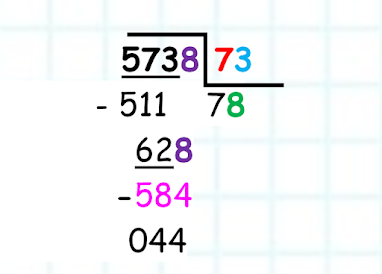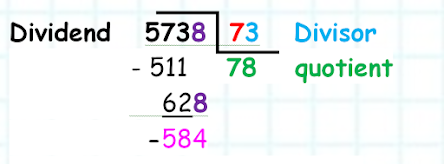Lesson 6
Division of Natural Numbers
Objective: To know what division is and identify its parts.
Keywords: Division, dividend, divisor, quotient, remainder.
Vocabulary
|
Nº |
English |
Spanish |
|
1 |
Close |
Cerca/Cercano |
|
2 |
Dividend |
Dividendo |
|
3 |
Divisor |
Divisor |
|
4 |
Look
for |
Buscar |
|
5 |
Multiplication
tables |
Tablas
de multiplicar |
|
6 |
Quotient |
Cociente |
|
7 |
Remainder |
Residuo |
|
8 |
Share |
Compartir |
|
9 |
Split
into |
Dividir
en |
|
10 |
Solve |
Resolver |
|
11 |
Terms |
Términos |
|
12 |
Turn |
Turno |
Lesson Plan Nº6 - English version
Lesson Plan Nº6 - Spanish version
Let’s learn about:
The division is a method of distributing
a group of things into equal parts. It is one of the four basic operations of
arithmetic, which gives a fair result of sharing.
|
Remember: The division is an operation inverse of multiplication
|
The division also has
its part or terms. Pay attention to the following example: 22 divided by 5.
For making a division,
it is important that you know the multiplication
tables since they will help you solve a division.
Pay attention to this
example:
There are 12
chocolates and 3 friends want to share them.
How do they divide the
chocolate?
In this case, we take 12 chocolates, and we divide them by 3 friends.
Step Nº 1: Look for a number in the table of 3 that results in 12 or is close to this number.
In this case, 4 is the number because 3 x 4 = 12 and 4 will be the quotient
Step
Nº 2: Multiply the Divisor (3) and the quotient (4)
Step Nº 3: Subtract twelve (12) and (12)
So, 12 ÷ 3 = 4 that means that each person must take 4 chocolates
Now, there is another example:
Step Nº 1: Take the first digits of the dividend: in this case 57. But as 57 is smaller than 73, you have to take one more digit: 573.
Step Nº 2: To divide 573 by 73, we take the first three digits of
the dividend: 573 and divide
them by the first digit of the divisor (7):
If we continue with the previous example, we would have to divide 57 by 7. Since 8 x 7 = 56, we will try 8.
We multiply 73 x 8 = 584 and since
584 is greater than 573, the 8 does not fit, so we would have to try with the
previous number.
73 x 7 = 511 and since 511 is smaller
than 573, the 7 if possible and we could do the subtraction of 573 - 511 = 62.
Step Nº 3: Lower the next digit and divide as in the previous
step until there are no more digits.
Step Nº 4: Repeat the same procedure until there are no more
digits.
We take again the first two
digits 62 and we would have to divide them by 7. Since 8 x 7 = 56
We write 8 in the quotient and multiply
73 x 8 = 584.
Since 584 is smaller than 628, we proceed to do the subtraction 628 - 584 = 44.
There are no more numbers to
go down, we have finished the division! The result is 78 and the remainder is
44.
Types of Divisions
The above division might look easy but things get complicated as you move forward and
that is why you should be aware of types of divisions. There are two types of
division that you might encounter.
1. Exact
Division
If you
divide a number and the answer that you receive is zero that means it is an
exact division. An exact division will always have the remainder zero (o).
2. Not Exact
Division
If you divide a number but in the end, you still get a number that isn't divisible by the divisor that is the case of not exact division. The number which isn't divisible by the divisor is called the remainder. In simple words, a division is not exact when the remainder is not zero.
Let’s watch the following video!
Let’s practice!
















